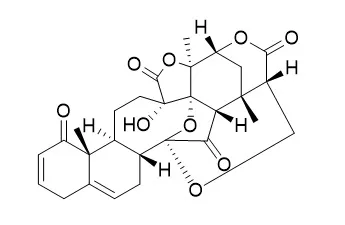| Description: |
Physalin B shows antimalarial, anti-Trypanosoma cruzi, anti-bacterial, anti- leukemia activities, it has the potential to be developed as an effective chemotherapeutic lead compound for the treatment of malignant melanoma, it inhibits androgen-independent prostate cancer cell growth through activation of cell apoptosis and downregulation of androgen receptor expression. Physalin B exhibits a minimum inhibitory concentration value (MIC) against Mycobacterium tuberculosis H(37)Rv strain of 32 microg/mL. Physalin B also presents antinociceptive properties associated with central.
|
| In vitro: |
| J Nat Prod. 2011 Oct 28;74(10):2269-72. | | Antimalarial activity of physalins B, D, F, and G.[Pubmed: 21954931] |
METHODS AND RESULTS:
The antimalarial activities of Physalin B, physalin D, physalin F, and physalin G (1-4), isolated from Physalis angulata, were investigated. In silico analysis using the similarity ensemble approach (SEA) database predicted the antimalarial activity of each of these compounds, which were shown using an in vitro assay against Plasmodium falciparum. However, treatment of P. berghei-infected mice with 3 increased parasitemia levels and mortality, whereas treatment with 2 was protective, causing a parasitemia reduction and a delay in mortality in P. berghei-infected mice.
CONCLUSIONS:
The exacerbation of in vivo infection by treatment with 3 is probably due to its potent immunosuppressive activity, which is not evident for 2. | | Anticancer Res. 1992 Jul-Aug;12(4):1155-62. | | Inhibitory effects of physalin B and physalin F on various human leukemia cells in vitro.[Pubmed: 1503404] |
METHODS AND RESULTS:
Physalins B and F were isolated and characterized from the ethanolic extract of the whole plant of Physalis angulata L. (Solanaceae). Both Physalin B and physalin F inhibited the growth of several human leukemia cells: K562 (erythroleukemia), APM1840 (acute T lymphoid leukemia), HL-60 (acute promyelocytic leukemia), KG-1 (acute myeloid leukemia), CTV1 (acute monocytic leukemia) and B cell (acute B lymphoid leukemia). Physalin F showed a stronger activity against these leukemia cells than Physalin B, especially against acute myeloid leukemia (KG-1) and acute B lymphoid leukemia (B cell).
CONCLUSIONS:
From the structural features, the active site seems to be the functional epoxy group for physalin F and the double bond for Physalin B located at carbon 5 and 6; the former is much more active than the latter as regards anti-leukemic effects. | | Parasitology. 2013 Dec;140(14):1811-21. | | Physalins B and F, seco-steroids isolated from Physalis angulata L., strongly inhibit proliferation, ultrastructure and infectivity of Trypanosoma cruzi.[Pubmed: 24001147] | We previously observed that physalins have immunomodulatory properties, as well as antileishmanial and antiplasmodial activities.
METHODS AND RESULTS:
Here, we investigated the anti-Trypanosoma cruzi activity of Physalin B, Physalin D, physalin F and physalin G. We found that Physalin B and physalin F were the most potent compounds against trypomastigote and epimastigote forms of T. cruzi. Electron microscopy of trypomastigotes incubated with Physalin B showed disruption of kinetoplast, alterations in Golgi apparatus and endoplasmic reticulum, followed by the formation of myelin-like figures, which were stained with MDC to confirm their autophagic vacuole identity. Physalin B-mediated alteration in Golgi apparatus was likely due to T. cruzi protease perturbation; however physalins did not inhibit activity of the trypanosomal protease cruzain. Flow cytometry examination showed that cell death is mainly caused by necrosis. Treatment with physalins reduced the invasion process, as well as intracellular parasite development in macrophage cell culture, with a potency similar to benznidazole. We observed that a combination of physalins and benznidazole has a greater anti-T. cruzi activity than when compounds were used alone.
CONCLUSIONS:
These results indicate that physalins, specifically B and F, are potent and selective trypanocidal agents. They cause structural alterations and induce autophagy, which ultimately lead to parasite cell death by a necrotic process. | | Phytother Res. 2002 Aug;16(5):445-8. | | Antimycobacterial physalins from Physalis angulata L. (Solanaceae).[Pubmed: 12203265 ] | Crude extracts and fractions from aerial parts of Physalis angulata have been bioassayed for antimycobacterial activity.
METHODS AND RESULTS:
Fraction A1-29-12 containing Physalin B,physalin F and physalin D exhibited a minimum inhibitory concentration value (MIC) against Mycobacterium tuberculosis H(37)Rv strain of 32 microg/mL. Purified Physalin B and physalin D were also tested showing MIC values against Mycobacterium tuberculosis H(37)Rv strain of > 128 microg/mL and 32 microg/mL respectively, suggesting that physalin D plays a relevant role in the antimycobacterial activity displayed.
CONCLUSIONS:
Structural elucidation of both physalin D and Physalin B was based on detailed (13)C and (1)H NMR spectral analysis with the aid of 2D-correlation spectroscopy ((1)H-(1)H, COSY, HSQC and HMBC). The assignment of the (13)C chemical shift for physalin D is reported here for the first time. |
|






 Cell. 2018 Jan 11;172(1-2):249-261.e12. doi: 10.1016/j.cell.2017.12.019.IF=36.216(2019)
Cell. 2018 Jan 11;172(1-2):249-261.e12. doi: 10.1016/j.cell.2017.12.019.IF=36.216(2019) Cell Metab. 2020 Mar 3;31(3):534-548.e5. doi: 10.1016/j.cmet.2020.01.002.IF=22.415(2019)
Cell Metab. 2020 Mar 3;31(3):534-548.e5. doi: 10.1016/j.cmet.2020.01.002.IF=22.415(2019) Mol Cell. 2017 Nov 16;68(4):673-685.e6. doi: 10.1016/j.molcel.2017.10.022.IF=14.548(2019)
Mol Cell. 2017 Nov 16;68(4):673-685.e6. doi: 10.1016/j.molcel.2017.10.022.IF=14.548(2019)